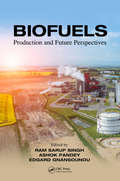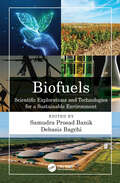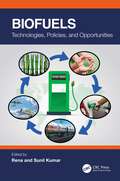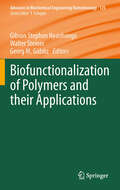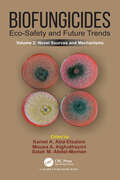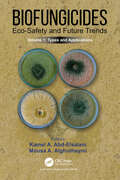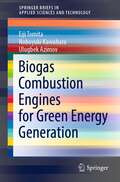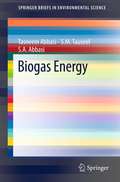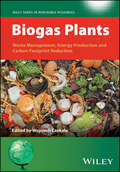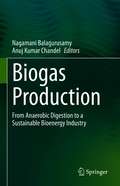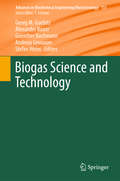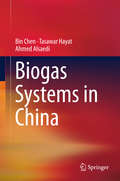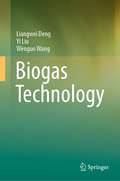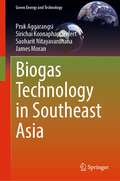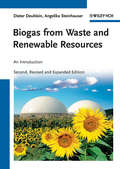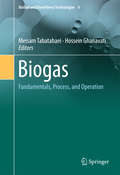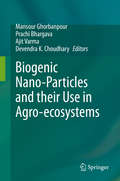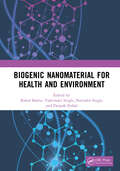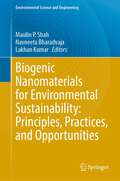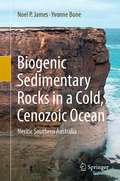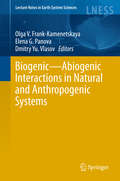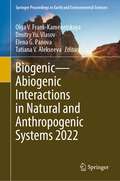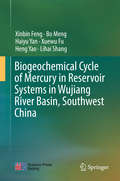- Table View
- List View
Biofuels: Production and Future Perspectives
by RAM SARUP SINGH, ASHOK PANDEY AND EDGARD GNANSOUNOUThis will be a comprehensive multi-contributed reference work, with the Editors being highly regarded alternative fuels experts from India and Switzerland. There will be a strong orientation toward production of biofuels covering such topics as biodiesel from renewable sources, biofuels from biomass, vegetable based feedstocks from biofuel production, global demand for biofuels and economic aspects of biofuel production. Book covers the latest advances in all product areas relative to biofuels. Discusses coverage of public opinion related to biofuels. Chapters will be authored by world class researchers and practitioners in various aspects of biofuels. Provides good comprehensive coverage of biofuels for algae. Presents extensive discussion of future prospects in biofuels.
Biofuels: Scientific Explorations and Technologies for a Sustainable Environment
by Debasis Bagchi Samudra Prosad BanikBiofuels are promising eco-friendly, renewable energy alternatives, simultaneously curbing the dependence on depleting fossil fuel reserves, reducing the global carbon footprint. However, there have been technological constraints deterring the global wide-scale adoption of biofuel. Biofuels: Scientific Explorations and Technologies for a Sustainable Environment presents a comprehensive analysis of different types of biofuels. Five sections provide detailed information on the history and discovery of biofuels, first-generation biofuels, second-generation biofuels, third-generation biofuels, and beyond, as well as prospects of biofuels as cleaner and greener alternatives.FEATURES Introduces the history of the origin of biofuels Narrates the evolution of biofuel raw material beyond generations, from food crops to plastic waste Explains the application of primary biofuel types: biodiesel, bioethanol, and biohydrogen Discusses the promises and prospects of biofuel for a cleaner, sustainable future Biofuels: Scientific Explorations and Technologies for a Sustainable Environment analyzes the promising future of biofuel technology and its judicious use to minimize dependency on fossil fuels. It is designed for academia, scientists, and researchers, as well as industrialists, environmentalists, biofuel technicians, R&D industries, and those from the petroleum industry.
Biofuels: Technologies, Policies, and Opportunities
by Sunil Kumar RenaOffering a comprehensive overview of biofuels and bioenergy systems, Biofuels: Technologies, Policies, and Opportunities describes advances in technologies and global policies around biofuels as a renewable energy source. It discusses the basics of biofuel and bioenergy systems and current status and potential challenges in developed and developing countries. The book also highlights the questions that should be asked, available options, and processes (conventional and advanced) to enhance biofuel production. Details how technological interventions can influence the operation of an effective bioenergy system. Presents information regarding renewable energy directives and global policies related to energy chains, energy models, market status, and appropriateness of technology selection for different generations of biofuel generation. Covers socio-economic aspects and techno-economic feasibility as well as a detailed life cycle simulations (LCS) approach, revealing the real constraints being faced in the biofuels sector. Helps bioenergy professionals to prepare a roadmap for day-to-day operations. Describes recent advances such as biohythane, advanced oxidation process, and nanocatalyzed pretreatment for biofuel generation from wastewater. Addresses the most commonly discussed issues in the biofuel sector and the rationales underpinning them. Written for professionals, academic researchers, decision makers, and policymakers in the biofuel sector, this book provides readers with a wide-ranging review of current research and developments in the respective field.
Biofunctionalization of Polymers and their Applications: Biofunctionalization Of Polymers And Their Applications (Advances in Biochemical Engineering/Biotechnology #125)
by Georg Gübitz Gibson Stephen Nyanhongo Walter SteinerChitin, Chitosan and Derivatives for Wound Healing and Tissue Engineering, by Antonio Francesko and Tzanko Tzanov Polyhydroxyalkanoates (PHA) and their Applications, by Guo-Qiang Chen.- Enzymatic Polymer Functionalisation: Advances in Laccase and Peroxidase Derived Lignocellulose Functional Polymers, by Gibson S. Nyanhongo, Tukayi Kudanga, Endry Nugroho Prasetyo and Georg M. Guebitz.- Lipases in Polymer Chemistry, by Bahar Yeniad, Hemantkumar Naik and Andreas Heise.- Enzymes for the Biofunctionalization of Poly(Ethylene Terephthalate), by Wolfgang Zimmermann and Susan Billig.- Biology of Human Hair: Know Your Hair to Control It, by Rita Araújo, Margarida Fernandes, Artur Cavaco-Paulo and Andreia Gomes.- Recombinamers: Combining Molecular Complexity with Diverse Bioactivities for Advanced Biomedical and Biotechnological Applications, by José Carlos Rodríguez-Cabello, María Pierna, Alicia Fernández-Colino, Carmen García-Arévalo and Francisco Javier Arias.- Biomimetic Materials for Medical Application Through Enzymatic Modification, by Piergiorgio Gentile, Valeria Chiono, Chiara Tonda-Turo, Susanna Sartori and Gianluca Ciardelli.- Supramolecular Polymers Based on Cyclodextrins for Drug and Gene Carrier Delivery, by Jia Jing Li, Feng Zhao and Jun Li.- Engineering Liposomes and Nanoparticles for Biological Targeting, by Rasmus I. Jølck, Lise N. Feldborg, Simon Andersen, S. Moein Moghimi and Thomas L. Andresen.-
Biofungicides: Novel Sources and Mechanisms, Volume 2
by Kamel A. Abd-Elsalam Mousa A. Alghuthaymi Salah M. Abdel-MomenThe current volume focuses on novel sources of biofungicides, primarily providing complete knowledge of microbial and phytochemical fungicides, studying antifungal activity mechanisms as well as their role in disease management in plants, and fungicide bioremediation. The use of biofungicides as eco-friendly alternative to typical synthetic fungicides is projected to play a significant role in organic farming in the future.Key Features: Discovers novel sources of biofungicides Describes the role of biofungicides in the control of plant diseases Studies antifungal activity mechanisms Explores how to survey and select promising biofungicides
Biofungicides: Types and Applications, Volume 1
by Kamel A. Abd-Elsalam Mousa A. AlghuthaymiThe current volume focuses on all the major concerns associated with the biofungicides and provides comprehensive knowledge of microbial and phytochemical fungicides, bioformulations, regulation as well as limitation of biofungicides, and their role in disease management in plants. The use of biofungicides as eco-friendly alternative to traditional synthetic fungicides is likely to play a major role in organic farming in the future.
Biogas Combustion Engines for Green Energy Generation (SpringerBriefs in Applied Sciences and Technology)
by Eiji Tomita Nobuyuki Kawahara Ulugbek AzimovThis book deals with the combustion and exhaust emissions of gas engines fueled with green biogas. Biogas is a mixture of gases, primarily consisting of methane and carbon dioxide. Biogas can be produced from raw materials such as agricultural waste, manure, municipal waste, plant material, sewage, food waste, etc. Biogas is considered to be a renewable source of energy. Therefore, it can contribute to the prevention of global warming.The biogas engine is used to co-generate electricity by operating engine and heat from hot exhaust gases. The energy source used very efficiently. Unlike other green energy sources such as wind and solar, biogas is readily available when needed.This book first describes the basics of biogas and its application to internal combustion engines. Next, it describes the engine system and the combustion phenomena in the engine cylinder. Engine technology continues to advance in spark ignition and dual-fuel engines to achieve higher thermal efficiency and lower harmful emissions. Several advanced combustion technologies are introduced to achieve higher thermal efficiency while avoiding knocking.
Biogas Energy (SpringerBriefs in Environmental Science #2)
by Tasneem Abbasi S. M. Tauseef S. A. AbbasiIn recent years, the importance of biogas energy has risen manifold and has become universal. This is due to the realization that biogas capture and utilization has great potential in controlling global warming. By capturing biogas wherever it is formed, we not only tap a source of clean energy, but we also prevent the escape of methane to the atmosphere. Given that methane has 25 times greater global warming potential than CO2, methane capture through biogas energy in this manner can contribute substantially towards global warming control.
Biogas Plants: Waste Management, Energy Production and Carbon Footprint Reduction (Wiley Series in Renewable Resource)
by Christian V. StevensComprehensive resource highlighting the global significance of biogas and reviewing the current status of biogas production. Biogas Plants presents an overview of biogas production, starting from the substrates (characteristics, pretreatment, and storage), addressing technical and technological aspects of fermentation processes, and covering the environmental and agricultural significance of obtained digestate. Written by a team of experts with extensive theoretical and practical experience in the areas of bio-waste, biogas plants, and reduction of greenhouse gas emissions, Biogas Plants discusses keys topics including: Anaerobic digestion, including discussion of substrates and products Advantages of biogas plants, with emphasis on their future potential for stable and controlled renewable energy Global significance of the biogas sector, including its importance in electro-energy system stabilization, biogas plants for energy storage, bio-waste utilization, and biomethane productionA thorough and complete resource on the subject, Biogas Plants will appeal to academic researchers and industry scientists and engineers working in the fields of biogas, bio-waste, bioenergy, renewable resources, waste management and carbon reduction, along with process engineers, environmental engineers, biotechnologists, and agricultural scientists. For more information on the Wiley Series in Renewable Resources, visit www.wiley.com/go/rrs
Biogas Production: From Anaerobic Digestion to a Sustainable Bioenergy Industry
by Anuj Kumar Chandel Nagamani BalagurusamyThis book focuses on biogas production by anaerobic digestion, which is the most popular bioenergy technology of today. Using anaerobic digestion for the production of biogas is a sustainable approach that simultaneously also allows the treatment of organic waste. The energy contained in the substrate is released in the form of biogas, which can be employed as a renewable fuel in diverse industrial sectors. Although biogas generation is considered an established process, it continues to evolve, e.g. by incorporating modifications and improvements to increase its efficiency and its downstream applications. The chapters of this book review the progress made related to feedstock, system configuration and operational conditions. It also addresses microbial pathways utilized, as well as storage, transportation and usage of biogas. This book is an up-to-date resource for scientists and students working on improving biogas production.
Biogas Science and Technology (Advances in Biochemical Engineering/Biotechnology #151)
by Georg Gübitz Alexander Bauer Guenther Bochmann Andreas Gronauer Stefan WeissMichael Lebuhn, Stefan Weiß, Bernhard Munk, Georg M. Guebitz Microbiology and Molecular Biology Tools for Biogas Process Analysis, Diagnosis and Control Veronika Dollhofer, Sabine Marie Podmirseg, Tony Martin Callaghan, Gareth Wyn Griffith & Katerina Fliegerová Anaerobic Fungi and their Potential for Biogas Production Bianca Fröschle, Monika Heiermann, Michael Lebuhn, Ute Messelhäusser, Matthias Plöchl Hygiene and Sanitation in Biogas Plants Charles-David Dubé and Serge R. Guiot Direct Interspecies Electron Transfer in Anaerobic Digestion: A Review Simon K. -M. R. Rittmann A Critical Assessment of Microbiological Biogas to Biomethane Upgrading Systems Manfred Lübken, Pascal Kosse, Konrad Koch, Tito Gehring, Marc Wichern Influent Fractionation for Modeling Continuous Anaerobic Digestion Processes Fermoso, F. G, van Hullebusch, E. D, Guibaud, G, Collins, G, Svensson, B. H, Carliell-Marquet, C, Vink, J. P. M, Esposito, G, Frunzo, L Fate of Trace Metals in Anaerobic Digestion
Biogas Systems in China
by Ahmed Alsaedi Bin Chen Tasawar HayatThis book derives an explicit analytical pattern (or framework) that permits the examination and optimization of biogas production systems. It provides a concise overview of the current status of biogas and biogas coupled agricultural systems in China, and introduces evaluation methods for energy efficiency, environmental emissions, economic performance and sustainability assessment approaches. Based on empirical studies, it also explores future options for the system development by focusing on emissions mitigation, biogas energy efficiency and system sustainability. Systematic methods of life cycle assessment and thermodynamic analysis may provide new angles for biogas system evaluation. The system discussed is not only a biogas producer, but also a biogas-linked ecological agricultural system, which has the potential to broaden the applicable scopes of renewable energy and eco-agricultural management. The comprehensive, in-depth knowledge and experience presented provide new analytical approaches for researchers in relevant fields and shed light on the construction and operation of emerging anaerobic digestion and biogas industries. This book is a valuable resource for researchers focusing on biogas system modeling, project managers and policymakers.
Biogas Technology
by Yi Liu Liangwei Deng Wenguo WangThis book focuses on agricultural waste treatment and renewable energy production from the perspective of anaerobic digestion. It covers topics on anaerobic digestion processes and practices in various types of biogas plant construction and management and systematically addresses the principle and main features of three kinds of anaerobic digestion systems: household digesters, biogas septic tanks, and biogas plants. Instructive, informative and easy to understand, the book offers a valuable asset for researchers, technicians, graduate students and managerial personnel working in the areas of renewable energy, agricultural ecological engineering and the treatment and utilization of agricultural wastes.
Biogas Technology in Nigeria
by Isaac Nathaniel Itodo Eli Jidere Bala Abubakar Sani SamboThis book provides comprehensive and simplified coverage of fundamentals of biogas such as production, purification, storage, methods of improving yield and utilization, types, construction, design and operation of biogas plants. It covers stepwise design and a manual for construction of biogas plants including a planning guide, profitability analysis and evaluation of biogas plants. The biogas energy profile in Nigeria is exclusively covered. Features: Explores planning for biogas plants as a pre-requisite to develop a functional plant balancing energy production and consumption. Gives out detailed provision of the types of substances that are and can be used for biogas production covering animal, municipal, and industrial wastes. Provides knowledge for aspiring biogas producers as well as decision makers, specifically in the context of Nigeria. Covers use of digestrate for anaerobic digestion as a waste treatment method and on the input (feedstock) to the biogas plant. Compares carbon dioxide emissions from biogas plants with fossil fuel plants. This book aims at Graduate Students and Researchers in Agricultural, Environmental, Chemical, Civil and Energy engineering and related professional audience.
Biogas Technology in Southeast Asia (Green Energy and Technology)
by James Moran Sirichai Koonaphapdeelert Pruk Aggarangsi Saoharit NitayavardhanaThis book on biogas is about the production and use of biogas with an emphasis on the raw materials and processes suitable for use in Southeast Asia. It is a gas formed when organic matter decomposes in an anaerobic digestion process. It can be made from any organic substance but the most economic are organic products from waste such as agricultural or general household waste, sewage, manure, municipal waste or food waste. As this raw material can be renewed indefinitely, biogas produced from it, is considered a renewable energy source. Worldwide interest in renewable energy sources is gathering momentum especially as concern for climate change mounts. Biogas generation helps reduce reliance on the use of fossil fuels. Producing biogas through biodigestion is non-polluting as there is no combustion or energy addition especially in the warmer climes of Southeast Asia. In this region, poorly managed landfills allow toxic liquids to drain into underground water sources. If instead, these wastes were used in a biogas plant, water pollution would be reduced. The same argument could be made for the local air quality. Therefore, biogas generation, in addition to producing renewable energy, also improves local water and air quality. The solid end-waste product of the biogas generation process is enriched natural organic matter (digestate), which can be substituted for chemical fertilizers, providing another environmental benefit to biogas. This book is primarily concerned with the production of biogas. From the raw material pre-treatment to the reactor design and operation to the post-treatment system, this book covers all aspects of production. There are many types of biogas reactors, each with their own advantages. Which reactor to select depends on the type and quantity of raw material, land area available and climate, among other factors. This book provides information on selecting and operating a suitable biogas system for interested parties be they governmental, NGO’s, private companies or individuals. Biogas contains primarily methane (CH4) and carbon dioxide (CO2). It may also contain small quantities of carbon monoxide (CO), hydrogen sulfide (H2S), moisture and siloxanes. Extracting the methane from all other gases is called biogas upgrading and the output is then referred to as biomethane. These upgrading processes are not the subject of this book as they are already the subject of a previously published book.
Biogas from Waste and Renewable Resources: An Introduction
by Angelika Steinhauser Dieter DeubleinThe leading book on the market just got better: With its unique approach covering all aspects of setting up and running a biogas plant, this new edition has been expanded to include recent advances in biomass processing.The author is a key player in the field, who has designed numerous small- and industrial-scale biogas plants, and who is also a long-time lecturer on biogas production, thus combining didactical skill with real-life expertise. As such, he covers both the biological and technical aspects of biogas generation. The full range of biogas substrates and processing modes is explained, from agricultural and industrial waste to marine algae and sediment. On-site use of biogas for conversion into electricity, fuel and heat is also discussed, as are safety and regulatory issues. Many real-life examples of European biogas plants already in operation illustrate the contents, as do numerous schemes, diagrams and summary tables.For this new edition, biogas analytics and quality control required for feeding biogas into natural gas networks are included, as is a completely new chapter on the microbiology of biogas-producing bacterial communities.
Biogas: Fundamentals, Process, And Operation (Biofuel and Biorefinery Technologies #6)
by Meisam Tabatabaei Hossein GhanavatiThis book presents the state of the art in biogas production using anaerobic digestion technology, with an emphasis on waste utilization/valorization. Offering a comprehensive reference guide to biogas production from different waste streams, it covers various aspects of anaerobic digestion technology from the basics, i.e., microbiological aspects to prominent parameters governing biogas production systems, as well as major principles of their operation, analysis, process control, and troubleshooting. Written and edited by internationally recognized experts in the field of biogas production from both academia and industry, it provides in-depth and cutting-edge information on central developments in the field. In addition, it discusses and reviews major issues affecting biogas production, including the type of feedstock, pretreatment techniques, production systems, design and fabrication of biogas plants, as well as biogas purification and upgrading technologies. ‘Biogas: Fundamentals, Process, and Operation’ also addresses the application of advanced environmental and energy evaluation tools including life cycle assessment (LCA), exergy, techno-economics, and modeling techniques. This book is intended for all researchers, practitioners and students who are interested in the current trends and future prospects of biogas production technologies.
Biogenic Nano-Particles and their Use in Agro-ecosystems
by Ajit Varma Devendra K. Choudhary Mansour Ghorbanpour Prachi BhargavaSeveral nano-scale devices have emerged that are capable of analysing plant diseases, nutrient deficiencies and any other ailments that may affect food security in agro-ecosystems. It has been envisioned that smart delivery systems can be developed and utilised for better management of agricultural ecosystems. These systems could exhibit beneficial, multi-functional characteristics, which could be used to assess and also control habitat-imposed stresses to crops.Nanoparticle-mediated smart delivery systems can control the delivery of nutrients or bioactive and/or pesticide molecules in plants. It has been suggested that nano-particles in plants might help determine their nutrient status and could also be used as cures in agro-ecosystems. Further, to enhance soil and crop productivity, nanotechnology has been used to create and deliver nano fertilizers, which can be defined as nano-particles that directly help supply nutrients for plant growth and soil productivity. Nano-particles can be absorbed onto clay networks, leading to improved soil health and more efficient nutrient use by crops. Additionally, fertilizer particles can be coated with nano-particles that facilitate slow and steady release of nutrients, reducing loss of nutrients and enhancing their efficiency in agri-crops. Although the use of nanotechnology in agro-ecosystems is still in its early stages and needs to be developed further, nano-particle-mediated delivery systems are promising solutions for the successful management of agri-ecosystems. In this context, the book offers insights into nanotechnology in agro-ecosystems with reference to biogenic nanoparticles. It highlights the: • occurrence and diversity of Biogenic Nanoparticles• mechanistic approach involved in the synthesis of biogenic nanoparticles• synthesis of nanoparticles using photo-activation, and their fate in the soil ecosystem• potential applications of nanoparticles in agricultural systems• application and biogenic synthesis of gold nanoparticles and their characterization• impact of biogenic nanoparticles on biotic stress to plants• mechanistic approaches involved in the antimicrobial effects and cytotoxicity of biogenic nanoparticles• role of biogenic nanoparticles in plant diseases management• relevance of biological synthesized nanoparticles in the longevity of agricultural crops • design and synthesis of nano-biosensors for monitoring pollutants in water, soil and plant systems• applications of nanotechnology in agriculture with special refer to soil, water and plant sciencesA useful resource for postgraduate and research students in the field of plant and agricultural sciences, it is also of interest to researchers working in nano and biotechnology.
Biogenic Nanomaterial for Health and Environment
by Narinder Singh Rahul Badru Yadvinder Singh Deepak DubalThe book titled Biogenic Nanomaterial for Health and Environment covers the synthesis, characterization, and applications of nanomaterials synthesized using living organisms, like bacteria, algae, fungi, plants, and biomolecules derived from them. This book is intended to meet the needs of undergraduate and graduate-level students of chemistry, biology, nanotechnology, and chemical engineering disciplines. The book will also serve as a useful reference work for researchers working in the fields of nanochemistry, material science, biology, and industrial chemistry. FEATURES A systematic overview of the biogenic synthesis nanomaterial. Recent research results and pointers to the advancement in the field. Discussion of putative applications of biogenic nanomaterials in health and the environment, with a main emphasis on biocidal activity, disease diagnosis, drug delivery, and sensing and remediation of pollutants from the environment. This book is compiled in such a way that it aids in understanding the underpinning concepts of the biogenic synthesis of nanoparticles. The biogenic synthesis of nanoparticles delivers more important and effective prospects for nanotechnology researchers. The biomass derived from various organisms acts as a template for the synthesis of nanoparticles with desired structural and featural aspects. The rewards of employing biomass and molecules derived from organism of choice in the synthesis process of nanoparticles are able to enhance the electrochemical consistency, control particle size, reduce toxicity, and escalate reactivity in an eco-friendly way. This book will provide the latest insights into the synthesis of nanomaterials employing biomass, cell extract, or as a whole, of various organisms and their roles in the health and remediation of the environment.
Biogenic Nanomaterials for Environmental Sustainability: Principles, Practices, and Opportunities (Environmental Science and Engineering)
by Maulin P. Shah Navneeta Bharadvaja Lakhan KumarEnvironmental pollution is a worldwide concern now. A major section of the world population is struggling for drinking water. Polluted soil is resulting into low agricultural productivity and thus creating challenges in the way of sustainable livelihood of a large section of human population. Biological treatment can offer both green solutions for wastewater treatment and resource recovery as well. Like algal-based systems can be utilized for wastewater treatment and production of biofuels from the biomass grown on the wastewater. Bio-based nanomaterials have been extensively studied for their employability in the health care, process optimization, water resource management, dealing with environmental pollutants, biosensors, and many others. Bioprospecting of novel biological agents, bio-based products, and bioresource recovery are paving the way for sustainable development as they are providing local solutions for a number of problems.In this proposed book, we start with the introduction to bio-nanotechnological principles and later on discuss bio-based nanomaterials employability for a diverse range of applications from environment to energy to health care. This book provides with current trends in bio-nanotechnology for anthropogonic purposes, prospects, challenges, and way forward.
Biogenic Sedimentary Rocks in a Cold, Cenozoic Ocean: Neritic Southern Australia
by Noel P. James Yvonne BoneThis book documents and interprets the onshore Cenozoic temperate carbonate depositional system along the southern margin of Australia. These strata, deposited in four separate basins, together with the extensive modern marine system offshore, comprise the largest such cool-water carbonate system on the globe. The approach is classic and comparative but the information is a synthesis of recent research and new information. A brief section of introduction outlines the setting, modern comparative sedimentology offshore, and structure of the Cenozoic onshore. The core of the book is a detailed analysis and illustration of the four Eocene to Pleistocene successions. Deposits range from temperate carbonates, to biosiliceous spiculites, to marginal marine siliciclastics. Each unit is interpreted, as much as possible, based on our understanding of the modern offshore depositional system. A subsequent part concentrates on diagenesis both before and after the late Miocene uplift. It turns out that alteration in the two packages is entirely different. The preceding attributes of each succession are then interpreted on the basis of controlling factors such as tectonics, oceanography, climate, and glaciation of nearby Antarctica. This research has revealed new implications for the interpretation of specific attributes of cool-water carbonate sedimentology that could only be discovered from the rock record. Insights concerning cyclicity, reef mounds, biosiliceous deposition, and trophic resources are detailed in the next section. The concluding part focuses on global comparisons, especially the Mediterranean and New Zealand.
Biogenic--Abiogenic Interactions in Natural and Anthropogenic Systems: Abiogenic Interactions In Natural And Anthropogenic Systems (Lecture Notes in Earth System Sciences)
by Olga V. Frank-Kamenetskaya Elena G. Panova Dmitry Yu. VlasovThis book offers a collection of papers presented at the V International Symposium "Biogenic - abiogenic interactions in natural and anthropogenic systems" that was held from 20-22 October 2014 in Saint Petersburg (Russia). Papers in this book cover a wide range of topics connected with interactions between biogenic and abiogenic components in the lithosphere, biosphere and technosphere. The main topics include: biomineralization in geosystems, geochemistry of biogenic-abiogenic systems, biomineral interactions in soil, minerals in living organisms and biomimetic materials, medical geology, bioweathering and destruction of cultural heritage.
Biogenic—Abiogenic Interactions in Natural and Anthropogenic Systems 2022 (Springer Proceedings in Earth and Environmental Sciences)
by Olga V. Frank-Kamenetskaya Elena G. Panova Dmitry Yu. Vlasov Tatiana V. AlekseevaThe book represents a collection of papers presented at VII International Symposium "Biogenic-abiogenic interactions in natural and anthropogenic systems" that was held on 26-29 September 2022 in Saint Petersburg (Russia). Papers in this book cover a wide range of topics connecting with interactions between biogenic and abiogenic components in lithosphere, biosphere and technosphere. The main regarding topics are following: biomineralization in living organisms and nature-like materials; biomineralization in geosystems; geochemistry of biogenic-abiogenic systems; biomineral interactions in soil; interaction of microorganisms with natural and artificial materials; medical geology; philosophical aspects of interdisciplinary researchs
Biogeochemical Cycle of Mercury in Reservoir Systems in Wujiang River Basin, Southwest China
by Xinbin Feng Bo Meng Haiyu Yan Xuewu Fu Heng Yao Lihai ShangThis book presents an intensive study on the biogeochemical cycle of mercury in a river-reservoir system in Wujiang River Basin, the upper branch of the Yangtze River. Six reservoirs located in the mainstream of the Wujiang River and their corresponding inflow/outflow rivers were selected for inclusion in this study, which was conducted by researchers from the Institute of Geochemistry, Chinese Academy of Sciences. The concentration and distribution of Hg in reservoirs (the water column, sediment, sediment pore water), inflow/outflow rivers of reservoirs, and wet deposition in Wujiang River Basin were systematically investigated, and measurements were taken of the water/air exchange flux of gaseous elemental mercury (GEM). On the basis of the data gathered, a detailed mass balance of total mercury (THg) and methylmercury (MeHg) in the six reservoirs was developed. In addition, the book identifies the primary factors controlling Hg methylation in the river-reservoir system in Wujiang River Basin. The accumulation and bio-magnification of Hg species within food chains in reservoirs and human health risk of MeHg exposure through fish consumption are also included in this book.
Biogeochemical Dynamics at Major River-Coastal Interfaces
by Mead A. Allison Thomas S. Bianchi Thomas S. Bianchi Mead A. Allison Wei-Jun CaiThis volume provides a state-of-the-art summary of biogeochemical dynamics at major river-coastal interfaces for advanced students and researchers. River systems play an important role (via the carbon cycle) in the natural self-regulation of Earth's surface conditions by serving as a major sink for anthropogenic CO2. Approximately 90 percent of global carbon burial occurs in ocean margins, with the majority of this thought to be buried in large delta-front estuaries (LDEs). This book provides information on how humans have altered carbon cycling, sediment dynamics, CO2 budgets, wetland dynamics, and nutrients and trace element cycling at the land-margin interface. Many of the globally important LDEs are discussed across a range of latitudes, elevation and climate in the drainage basin, coastal oceanographic setting, and nature and degree of human alteration. It is this breadth of examination that provides the reader with a comprehensive understanding of the overarching controls on major river biogeochemistry.
